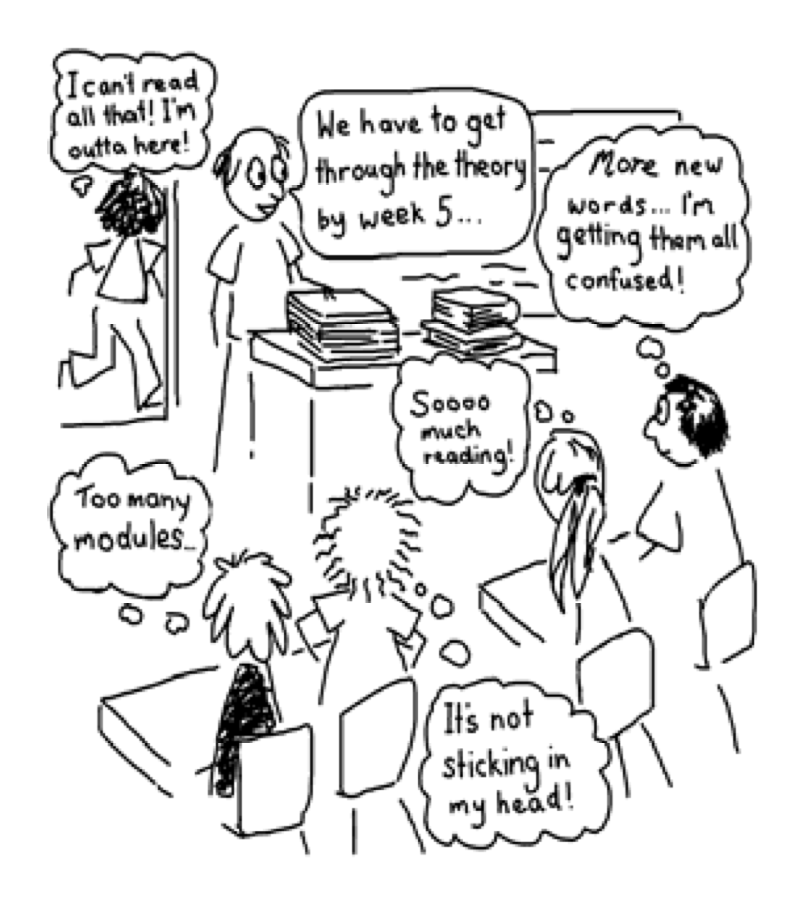Overcoming limited concentration spans
It is generally accepted that most people can only concentrate on information delivered orally by a presenter for 12 to 20 minutes. In particular, many practical TAFE programs tend to attract students who are ‘active’ learners: ie those who have not enjoyed academic studies in school and who do not learn well by listening or reading for long periods. They just cannot keep listening and concentrating on received information for extended periods of time.
Despite this, in the VET classroom it is common for ‘theory’ sessions to go far too long in the one mode of presentation. For example, expecting learners to read modules or listen to speakers’ presentations for whole sessions is not unusual. Even a professional looking PowerPoint presentation will be ineffective if it goes on for too long.
As famous author Mark Twain put it:

Breaking teacher presentations with student action – changing modes
Oral presentations or the spoken ‘delivery’ of information by the teacher are only effective if broken into small segments of 12-15 minutes maximum. These segments then need to be interspersed with some action on the students’ part. For instance, after 12 minutes of topic input, which usually means students are listening, give them a change. Provide an opportunity to speak, write or read for a short while. For example, read and then talk about a case study in small groups (something that is even possible in a lecture theatre); write during an application or individual problem solving task; or put the last concept into their own words by speaking to one or two other people.
Encouraging students to listen
It also helps students to listen to presentations if the spoken words have visual support. Remember, a well chosen ‘picture says a thousand words!’ Illustrations are particularly helpful for visual learners.
Visual learners, in fact most people, are also assisted by summaries or diagrams on an overhead or PowerPoint whilst you are talking. These can help clarify what you are saying and what is most important. They also aid student learning by reinforcing the message through two senses, seeing and hearing (visual and aural).
Use story telling techniques, for example, tales of your own related experiences from the workplace. These not only make the topic come alive but also aid memory. It is far easier to remember a story because the images or visual pictures they convey can be more accessible in illustrating a point. Again this is particularly helpful for students whose preferred learning style is visual.

Speaking aids student learning
Encouraging students to speak to one another and put ideas into their own words really helps them appreciate and remember the meanings behind the language and concepts. This can also be done by structuring short pair discussions of ideas into sessions, or providing opportunities to talk in groups or pairs about how newly introduced concepts will apply in particular cases.

‘Talking the talk’ of VET builds confidence
Strategies which facilitate students to speak in class, such as pair or small group discussions, also help to build student confidence in speaking the language of the vocational field, as well as general confidence at speaking up in class discussions.

‘a little at a time’
Encouraging students to speak in class
Speaking in class is a terrible fear for many students, so strategies for building their competence and confidence to speak up a little at a time are very useful. It is a good idea to do this from the start of the VET course. This sets the expectation of their participation early and allows the students to build up to it in small steps
To help students feel at ease speaking up in class it helps to know and trust the other members of the class.
Introductory or ‘Getting to know you’ activities during the initial class are a first step in this process. It is best to use pair or small group formats for this, rather than expecting students to speak to the whole class on their first day.
Encouraging students to work in new pair and group formations for the next few sessions will help them get to know even more students.
Confidence building activities during class sessions also help to build a supportive community. For example:
- Regular, quick ‘whip arounds’ of the class for opinions during discussions, or short answers to regular quizzes, keep students involved as well encouraging them to participate and discouraging them from hiding in the class.
- Exposing students to regular group and pair work also builds students’ confidence to speak, particularly if each member of the group is encouraged to report back at some stage. Speaking to at least one other person is also helpful for students to sort out their thinking before speaking about their ideas to the whole class.
- Encourage students to tell their own stories, perhaps from the workplace or even their life experiences related to the topics. People tend to find it easier to talk about their experiences rather than abstract ideas. As mentioned above, stories, whether from the teacher, or other students, are a powerful aid to understanding and memory.

Download this file as a PDF (176KB)
